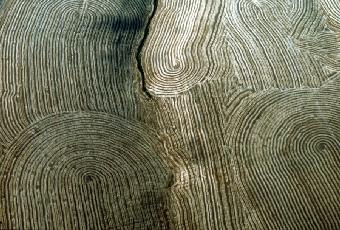Gerster 2: land prints
 Gerog Gerster. Harvest, Idaho, 1988
Gerog Gerster. Harvest, Idaho, 1988
Is ploughing, cutting and threshing so individual that their patterns act as a fingerprint? Something like the individuality of a welder's seam?
I would hazard that these are fields not part of the Dominion Survey, or in the States, the Land Ordinance Act, both of which divided the land into a 6 mile grid, implacable and immutable. Such fields are square, ploughed squarely, unless there is a slough, or an erratic, or some awkward bit of topography in the way. Or maybe farmers just get bored.
Well, no. The point of contour ploughing is to increase water retention in sloping soil and to prevent water erosion, survey grids notwithstanding. So something indicates the need for water conservation in these fields.
Gerster seems to have returned to this area, eastern Washington and Idaho many times. Almost all his work, which is from all over the world, is about the interaction of industrial practice with the landscape – the mark of man, the hand, the machine and the land.

